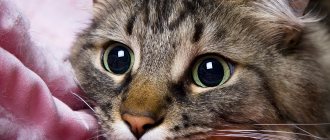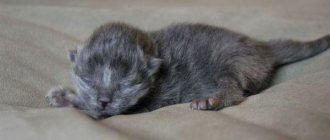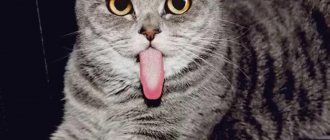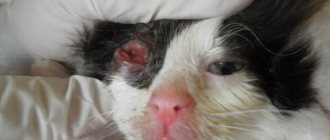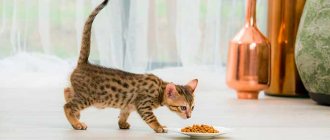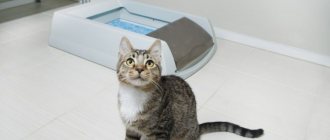Why can't the cat go to bed?
Oddly enough, this is a fairly common problem, especially among those breeders who save on the health of their pets. The thing is that economy-class food contains a large number of products, as well as food additives that contribute to the accumulation of salts. Thus, the environment of urine changes, and conditions are created that are favorable for the formation of stones. This is why pets who regularly eat cheap food often develop stones in the kidneys and bladder, which causes pain and difficulty defecating.
Why can't the cat go to bed:
- Congenital diseases . There are breeds that are predisposed to such diseases. They most often develop chronic diseases of the kidneys and urinary tract.
- Eating economy class food.
- Violation of containment conditions. The fact is that cats are afraid of drafts, as well as uncomfortable, uncomfortable places to rest that are not covered with fabric or a pillow.
- Consequences of sterilization. This is why it is necessary to sterilize cats at a certain age, since violation of age norms leads to the fact that they may develop problems with the urinary tract.
- Traumatization. Most often, males face urinary problems due to their aggressive nature. Cats are prone to injury and can fight, especially if they are outdoors.
- Stressful situations. Very often, communicating with dogs, traveling to exhibitions or traveling in a pet basket becomes real stress.
- Large body weight. Often occurs in males who have been castrated. Overeating contributes to obesity and the occurrence of additional pathologies, including the kidneys and urethra.
- Old age. Cats may indeed experience difficulty defecating due to old age.
cat
The cat does not go to the litter box: the reasons why this happened
There are several main reasons why a cat walks past the litter box. Each problem has its own solutions.
Be sure to read:
Causes and treatment of constipation in cats, how to help a cat go to the toilet in a big way
Medical reasons why the cat stopped going to the litter box
There are several medical reasons why a cat does not go to the litter box:
- Hormones. An unneutered cat will often prefer to mark territory rather than pee in a designated area. The use of traditional weaning methods, special medications or castration will help solve the problem.
- Diseases. Some illnesses cause pain during bowel movements or even prevent you from going to the toilet normally. These include intestinal inflammation, colitis, hepatitis, cystitis, urethritis, urolithiasis, etc.
- Elderly age. Cats over 7 years old often have problems with urination or defecation: urinary or fecal incontinence, etc.
In this case, consultation with a veterinarian is required.
Behavioral reasons
After ruling out health problems in your pet, you need to pay attention to behavioral characteristics.
There are several main reasons why a cat walks past the litter box.
Each animal has character traits, habits, and preferences. Changing external conditions leads to discomfort.
Motives:
- One more tray is missing. Cats are clean animals. One device may not be enough for them. The house should have one box with litter for the cat + another one in reserve.
- Stress. If your pet has recently had to live next to new animals, he experiences discomfort. Time needs to pass. It is advisable to help relieve stress in your pet: the trays should be different and placed in separate rooms.
- Inconvenient tray. Cats love comfort. The cat litter should be selected based on the size of the animal. High sides prevent burying and provide convenient placement.
- Consequences of recent illnesses. If your cat has recently suffered from cystitis or constipation, the litter box is associated with pain and discomfort.
- Unpleasant smell. The aroma in the room or the litter itself can repel the animal.
- Changing the filler. After changing the type or manufacturer of litter, the cat will stop going to the litter box if she doesn’t like it.
- Unpleasant conditioned reflexes associated with the toilet. Pets often scatter litter around the toilet. This behavior is inherent in nature; animals “bury” their feces. Sometimes owners begin to scold their pet for “garbage.” Such methods of education lead to the fact that he completely stops visiting the litter box.
Important! During heat, cats often refuse to use the litter box due to the inconvenience. Males do not go there in small ways, as they mark the territory.
The cat is yelling and can’t go to the toilet, what should I do?
Please note that the owner’s task is to alleviate the pet’s plight and help him go to the toilet. There are several ways to provoke urination.
The cat is yelling and can’t go to the toilet, what to do, how to understand that the cat needs help:
- He often stomps around in the litter box, spends a lot of time there, screams, but cannot go to the toilet.
- Feels unwell, there is apathy, worsening mood.
- The pet can break away from the owner’s hands and refuse the caresses that until recently he loved very much.
- The cat's temperature rises, or, conversely, decreases.
- The cat may refuse to eat or drink. Or, conversely, dryness occurs due to temperature.
- If the cat managed to pee, then there is a very small amount of urine, there is mucus, blood, and lumps in it.
Filler
Why the cat can’t go to the toilet: possible diseases
There are many reasons and it is necessary to monitor the animal for some time.
Why can't my cat go to the toilet?
- Presence of stones in the kidneys and bladder.
- Kidney diseases, pyelonephritis, nephrosis.
- Inflammation of the urethra.
- Urethritis and cystitis occur due to inflammation and infection of the canal. This usually occurs in males due to structural features.
- Often cystitis and urethritis occur due to hypothermia, or due to a descending infection, which is provoked by kidney diseases.
- Eating salty, smoked foods. As a result, the urethra becomes very narrow, and strong urine pressure cannot penetrate through the thin tube.
- The main cause of the disorder is urolithiasis. Occurs due to an increase in the concentration of calcium and other salts in the urine. Often occurs when consuming cheap food. The protein in them is partially absorbed, and nitrogenous substances accumulate in the form of salts and stones.
- Eating plenty of protein. The fact is that proteins cause an increase in nitrogenous waste in the urine. They are the ones who provoke the growth of pathogenic microflora inside the canals.
- Kidney pathologies occur due to acute infections, but most often appear due to the advanced age of the pet. If the cat is old, the kidneys do not filter waste well, causing the bladder to become a weak point.
- Constipation. Indigestion also often causes difficulty urinating. The intestines and bladder are connected to each other, so there may be difficulties with both bowel movements and urination. The intestines can put pressure on the bladder, which causes problems with going to the toilet.
On the toilet
How to prevent urinary retention?
To prevent the occurrence of urolithiasis, you should take care of your pet and monitor the conditions in which it is kept.
How to prevent urinary retention:
- In no case should you overfeed the animal and provoke an increase in body weight. After all, obesity often causes deterioration in the functioning of all organs.
- Conduct preventive deworming and vaccination.
- That is, it is necessary to undergo a medical examination and get vaccinations regularly.
- Under no circumstances should you give food or treats from the human table. They contain a large amount of salts and can be spicy, which causes disruption in the animal’s excretory system.
- It is worth using premium food, which is made on the basis of natural ingredients with a minimum content of additives and plant substances.
On the toilet
The cat can't go big: reasons
Animals have problems not only with the process of going to the toilet in a small way, but also with the act of defecation. In order to find out that a cat is suffering from constipation, it is necessary to clarify how many times the animal should go to the toilet. For small kittens, up to 21 weeks of age, 3-4 times a day is considered the norm.
If your pet is already 3-6 months old, then the norm is 2-3 times a day, and if it is an adult cat, from six months to 8 years, he can go to the toilet 1-2 times a day. If this is a mature cat, over 8 years old, the norm is once a day. In order to determine that an animal is constipated, it is necessary to evaluate the consistency of the stool. If it is very dry, dark brown in color, and contains foreign objects, the animal is constipated.
The pet is sleeping
It is worth noting that constipation can be a symptom of serious illnesses, and not an independent disease.
The cat cannot go big, reasons:
- Nutritional imbalance. That is, the food contains insufficient minerals and vitamins, a lot of carbohydrates, and a lack of proteins.
- The animal cleans itself very carefully, so there is a lot of hair in the intestines, which the pet does not regurgitate. Wools can retain feces in the intestines.
- The animal has swallowed a foreign object. These could be bones or small objects that clog the intestines, preventing the excretion of feces.
- Diseases of the gastrointestinal tract and metabolic disorders.
- Tumors in the intestinal area, as well as the genitourinary system, diabetes mellitus.
- Thyroid gland dysfunction.
- Obesity and urolithiasis.
- Parasites. Because of worms, a cat may not go to the toilet for a long period of time.
- Infectious diseases, stress.
On a tray
Doesn't walk small
So, if a cat goes to the toilet “little by little” less than 2 times a day, the process is accompanied by pain, screaming or bleeding, then something is clearly wrong with the cat’s body. Let's take a closer look at this pathology.
Reasons for violating the regime
There are several reasons why the process of emptying the bladder may be disrupted:
- Dehydration. Insufficient fluid intake or increased loss of moisture from the body can lead to hypovolemia. Hypovolemia may be caused by blood loss. In this case, less blood is filtered by the kidneys and less urine is produced.
- Obstruction of the urinary tract (urolithiasis). In this condition, urine is formed normally, but due to obstruction it cannot be released.
- Inflammatory kidney diseases, renal failure. Damage to the glomeruli can also lead to oliguria and even anuria (complete absence of urine).
- Poor nutrition. Excessive consumption of salty foods can also lead to fluid retention in the body.
Something else interesting: Cats have bad breath
Signs of difficulty
It is not difficult for an attentive owner to identify pathology. The pet rarely goes to the toilet, and even if it does, very little urine is released. While emptying its bladder, your cat may scream or moan, which is a sign that urination is painful. In addition, sometimes blood can be detected in the tray. Often the condition is accompanied by intoxication syndrome, as toxic substances accumulate that are normally excreted by the kidneys.
Help your pet
In order to help your pet, you need to determine the cause of the illness. Most often, this cannot be done at home. Therefore, if you notice signs of urinary retention, you should contact your veterinarian. He will prescribe an additional examination (general and biochemical blood tests, ultrasound), which will help determine the diagnosis. After this, appropriate treatment is prescribed.
If you understand that the cause is most likely dehydration, then you need to restore your hydration. To do this, give your cat liquid often, but in small portions.
In other cases, specific treatment is necessary. For inflammatory diseases, antibiotics are prescribed, and sometimes it is necessary to use infusion therapy and diuretics. In case of obstruction, catheterization of the bladder is performed, since an overfilled bladder can rupture.
How to help a cat go big?
In order to determine when a cat needs help, you need to take a closer look at its behavior and count how many days the animal does not go to the toilet in a big way. If you have not seen feces for 3 days, then you should take the animal to the veterinarian. If this is a kitten that is not yet six months old, but has not had a bowel movement for 36 hours, you should immediately consult a doctor. How can you help an animal go to the toilet more often?
How to help your cat go big:
- It is necessary to give an enema. To do this, it is advisable to give the animal about 3 ml of petroleum jelly to drink about an hour and a half before the manipulation. It is best to use chamomile decoction or soda solution as an enema solution.
- Please note that the enema liquid must have a temperature of 36 degrees. Next, the tip of a small syringe, which must be rubber, is lubricated with Vaseline or baby cream and carefully inserted into the animal’s anus.
- You should not insert the spout very deeply; it is enough to place it about 2-3 cm into the anus. The optimal amount of liquid that is poured into the animal’s intestines is 200-250 ml. Next, after removing the enema spout from the anus, you need to press the tail to the anus for 10 minutes.
- Next, you need to take the cat to the litter box so that he can empty himself. Under no circumstances should an enema be manipulated if the animal is bleeding or has injuries in the anal area. Please note that enema should not be performed frequently because it can cause dysbacteriosis.
- If your cat has persistent problems with defecation, reconsider its diet. A circular massage, starting from the breasts and ending with the lower abdomen, is very useful. In this case, you don’t need to press hard; stroking, circular movements are enough.
Pet
Why is this happening
There may be several reasons for the development of this condition:
- Acute intestinal obstruction. May develop as a result of obstruction by a foreign body (hairball, swallowed bag or cord), intussusception.
- Tumor in the large intestine. The tumor can compress the intestinal lumen and prevent the passage of feces.
- Inflammatory bowel diseases.
- Pathology of the anus. Mechanical damage to the sphincter, such as scar deformity, can make bowel movements difficult.
- Dietary disorder. Insufficient fiber and water intake, and dry food can lead to excessive dryness of stool, which makes it difficult to pass.
Something else interesting: Rules for choosing a veterinary clinic
How to recognize difficulties
In order to recognize the pathology, it is enough to carefully monitor your pet:
- The cat goes to the toilet less than once every 2 days.
- During the act of defecation she experiences pain.
- An admixture of blood, pus or mucus is detected in the feces.
Animal treatment
You can help your pet only after discovering the cause. If the cause is scar deformity, tumor or intussusception, surgical intervention is necessary. If the condition is caused by poor nutrition, you need to reconsider your diet and add more fluid. For inflammatory diseases, antibiotics are prescribed. Symptomatic treatment is the prescription of laxatives, but these drugs can only be used after consulting a veterinarian.
British cat can't go to the toilet, how can I help?
In order not to treat your cat and deal with constipation, it is necessary to prevent it. To do this, it is enough to follow the measures.
British cat cannot go to the toilet, how to help:
- Brush your animal during the shedding period.
- Buy special food that stimulates the removal of hair from the intestines.
- The animal's diet should be balanced and contain a large amount of fiber.
- Give your animal something to drink regularly. It is best if the drinking bowl is available during the day. Change the water constantly, it must be fresh.
- You definitely need to walk and play with your cat.
- Physical activity stimulates the process of defecation.
- Under no circumstances should you throw small objects around the house, as the animal may swallow them. See your doctor regularly for checkups and vaccinations.
Filler
How to help a cat go to bed?
Initially, an adult animal should walk in a small manner at least once a day. Moving and stressful situations often become a problem. Therefore, if an animal does not go to the toilet for 2 days, it is necessary to urgently take it to the doctor. If this is not possible at the moment, you can help the animal defecate. To do this you will have to perform several simple manipulations.
How to help a cat go small:
- A small amount of warm water is filled into a plastic bottle. Please note that its temperature should be approximately 42 degrees. Under no circumstances should a heating pad with hot water be applied to the animal’s belly.
- You can put the animal in warm water and hold it for several minutes. Try not to let the warm water reach the heart area. Thus, warm water will help relieve pain and spasms. You can give the animal no-shpa to drink.
- This will help if the reason for the lack of urination is a spasm in the bladder area. If it is urolithiasis, and the ducts are blocked by stones, then such manipulations will be useless.
Filler
Possible pathologies
If the cat has not gone to the toilet for more than 2 days or the process of emptying the bladder is carried out too rarely, the owner needs to be wary and help the animal as quickly as possible. Most often, infrequent urination is a symptom of urolithiasis, but sometimes such a disorder may indicate other developing pathologies.
- I'm ill…
In the absence of timely help, the disease will begin to progress, which will cause suffering to the animal. Only a veterinarian can make a reliable diagnosis and select a suitable treatment regimen after conducting a thorough physiological examination and evaluating test results.
If a cat cannot pee for a long time, the disorder is caused by one of the following reasons:
- Urolithiasis disease. Due to anatomical features, the pathology is more often diagnosed in cats than in cats. In addition, its development can be caused by poor diet and excess weight. KSD is formed due to various infections entering the animal’s body, which causes the development of the inflammatory process. With mechanical blockage of the canal, the problem with urination does not appear gradually, but abruptly. An animal can sit on a tray for a long time, but there will be no result.
- Injury to internal organs , for example, due to a fall from a height.
- Cystitis of a viral or bacterial nature. The main reason for the development of this disease is hypothermia. Pathology is often diagnosed in animals that walk outside.
- Formation of polyps on the bladder. Benign formations that resemble warts in appearance and are localized on the walls of the organ. Depending on their location, they can obstruct the flow of urine or cause incontinence.
- Kidney pathologies. The most common diseases of this type that occur in cats are nephritis and nephrosclerosis. Most often, such ailments also develop due to hypothermia, poor nutrition and infections.
- Colds and viral diseases.
- Atony. Impaired bowel function due to injury or rupture of the bladder.
- Anuria is the absence of urine due to severe dehydration.
One of the reasons is dehydration.
In some cases, problems with urination can be caused by congenital pathologies, but then the symptoms of the disorder will appear from the first months of the kitten’s life.
On a note! Urinary retention can be triggered by stress, for example, moving or having a new pet in the apartment.
The cat cannot go to pee and burps, what should I do?
Such symptoms are observed with constipation, poisoning and pyelonephritis. Only a veterinarian can make an accurate diagnosis.
The cat cannot go to pee and burps, what to do:
- If the cat does not go to the toilet for 2 days, it is necessary to urgently take him to the veterinary clinic. At the clinic, the cat will be provided with first aid. To empty the bladder, a catheter is inserted into the urethra to allow urine to flow out.
- This manipulation is usually performed under general anesthesia so as not to injure the walls of the animal’s bladder. The procedure is very painful and is not done often, but if the reason for the lack of urination is urolithiasis, and there is stone or sand in the area of the urethra and urethra, the doctor may install a temporary catheter for several days.
- In this case, a collar is put on the animal so that the pet does not accidentally pull out, damage the catheter, or make a wound in the area of the urethra. You must also follow all the doctor's recommendations. He may prescribe antibiotics, antispasmodics, as well as diuretics and stone-dissolving medications. It all depends on what caused the lack of urination.
Filler
A lot of interesting information about keeping cats can be found in our articles:
Is it possible to give cats human tablets, No-shpu, Valerian tablets? How to give a bitter pill to a cat without spitting it out?
What can you feed a 1-6 month old kitten without a cat and how many times a day: list of feeds, products and dishes, feeding regimen
Is it possible to leave a cat alone for a day, 5 days, a week, two weeks? How long can you keep a cat or kitten: reviews, veterinarians’ opinions
Why does a cat itch and lick itself, but there are no fleas? The cat is constantly itching: causes, methods of treatment
Of course, it is very difficult for the owner to determine the cause of difficulty urinating. Cysts, fibroids, fibroids often cause difficulty urinating in females. The only thing the owner can do in this case is to alleviate the animal’s condition, that is, provoke a trip to the toilet, and make an appointment with the veterinarian.
How many days can a kitten go without walking (stress when moving)
Kittens visit the litter box up to 3 times a day. More or less is considered a deviation in the functioning of the digestive tract. The first option (increasing trips to the toilet) indicates poor functioning of the gastric mucosa.
Be sure to read:
The cat tagged: how to remove odors, the best folk and chemical remedies, how to wash clothes and shoes
The second option may be an indicator of more serious problems with the baby’s health:
- inflammation of the gastrointestinal tract;
- adhesive disease;
- hernia and scarring;
- swelling or rupture of the anal canal.
But don't panic ahead of time. Kittens also experience problematic bowel movements after a long trip, weaning from their mother's milk, or when moving to a new home. The pet needs to be given some time to adapt. If after this the animal suffers from constipation, it is necessary to consult a veterinarian.



